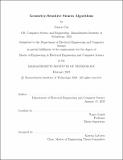Geometry-Sensitive Swarm Algorithms
Author(s)
Cai, Grace
DownloadThesis PDF (888.7Kb)
Advisor
Lynch, Nancy
Terms of use
Metadata
Show full item recordAbstract
Insect colonies, birds, and fish successfully coordinate themselves to make collective decisions through purely local interactions. Their behaviors have inspired the development of algorithms for robotic swarms. Robotic swarms consist of many simple and often identical agents that interact solely via local sensing and communication. Swarm algorithms seek to produce collective behaviors within the swarm such as aggregation, consensus achievement, and task allocation.
For both biological and robotic swarms, simulation is a powerful tool to facilitate analyzing and improving swarm models. While simulating swarm algorithms is very useful, detailed and realistic simulations can take a long time to run and gather feedback on. This often leads to simplifications, especially in the geometry of the problem, that are not representative of what swarms may see in the real word [4, 13, 44]. In this thesis, we present a new discrete modelling framework for swarm algorithms that allows agents to synchronously transition on a discrete grid. Using such a grid makes it easier to add geometric qualities to the agents’ environment and allows for parallel speedups in the simulation time when developing swarm algorithms or models of biological swarms.
Using our new framework, we study the existing swarm problems of house hunting and task allocation, and provide new algorithms which are more geometrically-sensitive than previous work [4, 13, 23, 32, 42, 44].
In Chapter 3, we develop a house hunting algorithm that is able to choose the best nest even when it is very far away from the swarm’s home nest or is being blocked by other poorer quality candidates. Our algorithm chooses the best quality nest much more consistently than previous work, which had not considered these geometrically challenging setups.
In Chapter 4, we develop two new task allocation algorithms for agents in an environment with unknown task locations and demands, and test these algorithms in environments of varying task density. We show that one of our algorithms, inspired by the communication of house-hunting agents via a home nest, outperforms Levy flight foraging in environments with sparse task density. Our other algorithm, inspired by communication via virtual pheromones, completes tasks even faster and performs
Date issued
2023-02Department
Massachusetts Institute of Technology. Department of Electrical Engineering and Computer SciencePublisher
Massachusetts Institute of Technology